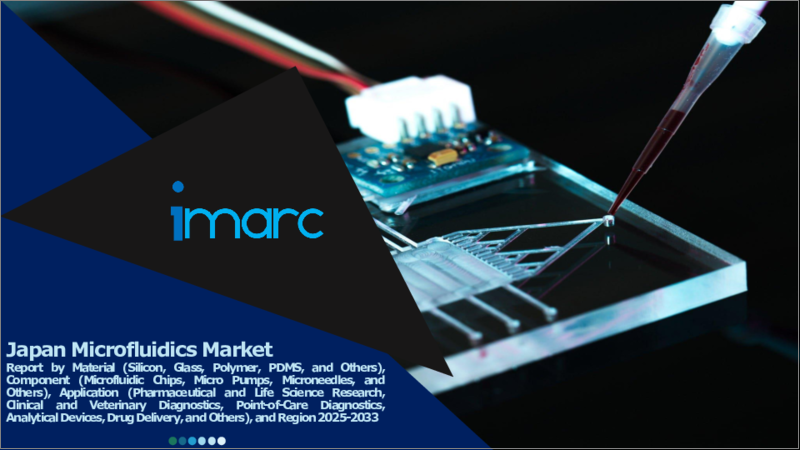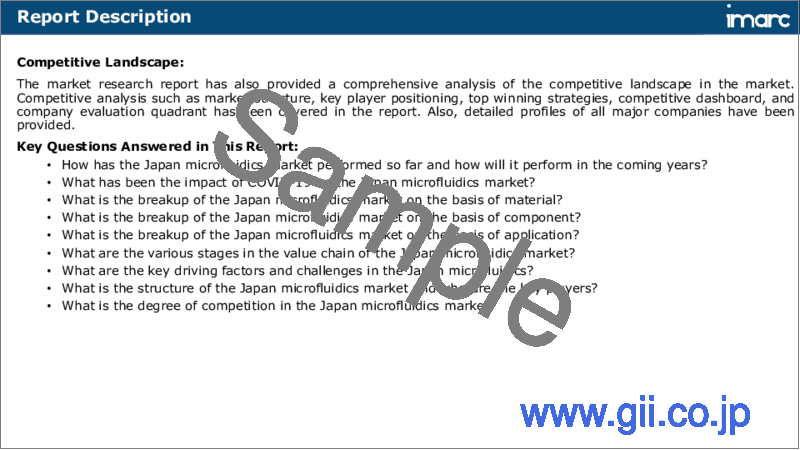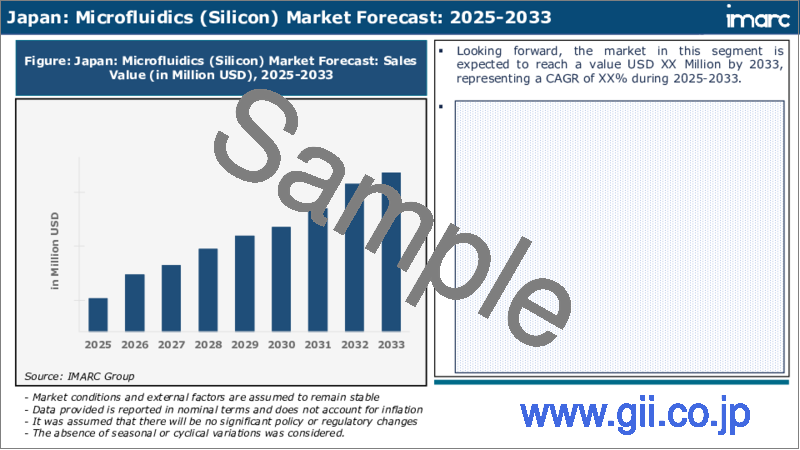|
|
市場調査レポート
商品コード
1609755
日本のマイクロ流体市場レポート:材料、コンポーネント、用途、地域別、2025年~2033年Japan Microfluidics Market Report by Material, Component, Application, and Region 2025-2033 |
||||||
カスタマイズ可能
|
|||||||
| 日本のマイクロ流体市場レポート:材料、コンポーネント、用途、地域別、2025年~2033年 |
|
出版日: 2024年12月05日
発行: IMARC
ページ情報: 英文 117 Pages
納期: 5~7営業日
|
全表示
- 概要
- 目次
日本のマイクロ流体市場の市場規模は2024年に21億米ドルに達しました。今後、IMARC Groupは、市場は2033年までに57億米ドルに達し、2025年から2033年の間に12%の成長率(CAGR)を示すと予測しています。拡大する飲食品業界と、汚染物質の検出、製品の一貫性の確保、食品の安全性向上に役立つマイクロ流体へのニーズの高まりが、主に市場を牽引しています。
本レポートで扱う主な質問
- 日本のマイクロ流体市場はこれまでどのように推移し、今後どのように推移するのか?
- COVID-19の日本のマイクロ流体市場への影響は?
- 日本のマイクロ流体市場の材料別内訳は?
- 日本のマイクロ流体市場のコンポーネント別内訳は?
- 日本のマイクロ流体市場の用途別の内訳は?
- 日本のマイクロ流体市場のバリューチェーンにはどのような段階がありますか?
- 日本のマイクロ流体における主な促進要因と課題は?
- 日本のマイクロ流体市場の構造と主要プレーヤーは?
- 日本のマイクロ流体市場における競合の程度は?
目次
第1章 序文
第2章 調査範囲と調査手法
- 調査の目的
- ステークホルダー
- データソース
- 市場推定
- 調査手法
第3章 エグゼクティブサマリー
第4章 日本のマイクロ流体市場:イントロダクション
- 概要
- 市場力学
- 業界動向
- 競合情報
第5章 日本のマイクロ流体市場情勢
- 過去および現在の市場動向(2019年~2024年)
- 市場予測(2025-2033)
第6章 日本のマイクロ流体市場:材料別の内訳
- シリコン
- ガラス
- ポリマー
- PDMS
- その他
第7章 日本のマイクロ流体市場:コンポーネント別の内訳
- マイクロ流体チップ
- マイクロポンプ
- マイクロニードル
- その他
第8章 日本のマイクロ流体市場:用途別の内訳
- 製薬および生命科学調査
- 臨床および獣医診断
- ポイントオブケア診断
- 分析装置
- ドラッグデリバリー
- その他
第9章 日本のマイクロ流体市場:競合情勢
- 概要
- 市場構造
- 市場プレーヤーのポジショニング
- 主要成功戦略
- 競合ダッシュボード
- 企業評価象限
第10章 主要企業のプロファイル
第11章 日本のマイクロ流体市場:業界分析
- 促進要因・抑制要因・機会
- ポーターのファイブフォース分析
- バリューチェーン分析
第12章 付録
Japan microfluidics market size reached USD 2.1 Billion in 2024. Looking forward, IMARC Group expects the market to reach USD 5.7 Billion by 2033, exhibiting a growth rate (CAGR) of 12% during 2025-2033. The expanding food and beverage industry, along with the increasing need for microfluidics to help in detecting contaminants, ensuring product consistency, and improving food safety, is primarily driving the market.
Microfluidics is a multidisciplinary field that deals with the manipulation of tiny amounts of fluids, typically at the microliter or nanoliter scale, within microscale channels or devices. This technology harnesses the unique physical properties of fluids at these small scales to perform a wide range of tasks, such as mixing, separation, and analysis. Microfluidic devices consist of channels, chambers, and valves etched or fabricated on a small chip. These devices find applications in various fields, including biotechnology, chemistry, medicine, and electronics. Researchers and engineers use microfluidics to conduct experiments, analyze biological samples, perform chemical reactions, and even create miniature diagnostic devices like lab-on-a-chip systems. The advantages of microfluidics include the ability to work with small sample volumes, precise control over fluid flow, rapid analysis, and potential cost savings. It has revolutionized areas like point-of-care diagnostics, drug development, and DNA sequencing by making complex processes more efficient, portable, and accessible. Microfluidics continues to drive innovation and has the potential to address numerous challenges in science and technology.
Japan Microfluidics Market Trends:
The microfluidics market in Japan is driven by a confluence of factors that propel its growth and innovation. To begin with, the healthcare sector is a prominent driver. The demand for point-of-care diagnostics and personalized medicine has surged, necessitating the development of miniaturized, precise, and portable microfluidic devices. Furthermore, the escalating need for efficient drug discovery and development in the pharmaceutical industry has spurred investments in microfluidics. Additionally, environmental concerns and the desire for sustainable practices have led to the application of microfluidics in areas such as water quality monitoring and environmental testing. Moreover, the electronics industry is a critical player in fueling the microfluidics market. With the ever-increasing demand for smaller and more powerful electronic components, the need for microfabrication techniques closely aligned with microfluidics is paramount. Furthermore, academia and research institutions continue to be instrumental in pushing the boundaries of microfluidics by fostering innovation and attracting funding for cutting-edge projects. In essence, the multifaceted drivers of the microfluidics market are interwoven, creating a dynamic landscape that promises significant technological advancements and widespread applications in the foreseeable future.
Japan Microfluidics Market Segmentation:
Material Insights:
- Silicon
- Glass
- Polymer
- PDMS
- Others
Component Insights:
- Microfluidic Chips
- Micro Pumps
- Microneedles
- Others
Application Insights:
- Pharmaceutical and Life Science Research
- Clinical and Veterinary Diagnostics
- Point-of-Care Diagnostics
- Analytical Devices
- Drug Delivery
- Others
Competitive Landscape:
The market research report has also provided a comprehensive analysis of the competitive landscape in the market. Competitive analysis such as market structure, key player positioning, top winning strategies, competitive dashboard, and company evaluation quadrant has been covered in the report. Also, detailed profiles of all major companies have been provided.
Key Questions Answered in This Report:
- How has the Japan microfluidics market performed so far and how will it perform in the coming years?
- What has been the impact of COVID-19 on the Japan microfluidics market?
- What is the breakup of the Japan microfluidics market on the basis of material?
- What is the breakup of the Japan microfluidics market on the basis of component?
- What is the breakup of the Japan microfluidics market on the basis of application?
- What are the various stages in the value chain of the Japan microfluidics market?
- What are the key driving factors and challenges in the Japan microfluidics?
- What is the structure of the Japan microfluidics market and who are the key players?
- What is the degree of competition in the Japan microfluidics market?
Table of Contents
1 Preface
2 Scope and Methodology
- 2.1 Objectives of the Study
- 2.2 Stakeholders
- 2.3 Data Sources
- 2.3.1 Primary Sources
- 2.3.2 Secondary Sources
- 2.4 Market Estimation
- 2.4.1 Bottom-Up Approach
- 2.4.2 Top-Down Approach
- 2.5 Forecasting Methodology
3 Executive Summary
4 Japan Microfluidics Market - Introduction
- 4.1 Overview
- 4.2 Market Dynamics
- 4.3 Industry Trends
- 4.4 Competitive Intelligence
5 Japan Microfluidics Market Landscape
- 5.1 Historical and Current Market Trends (2019-2024)
- 5.2 Market Forecast (2025-2033)
6 Japan Microfluidics Market - Breakup by Material
- 6.1 Silicon
- 6.1.1 Overview
- 6.1.2 Historical and Current Market Trends (2019-2024)
- 6.1.3 Market Forecast (2025-2033)
- 6.2 Glass
- 6.2.1 Overview
- 6.2.2 Historical and Current Market Trends (2019-2024)
- 6.2.3 Market Forecast (2025-2033)
- 6.3 Polymer
- 6.3.1 Overview
- 6.3.2 Historical and Current Market Trends (2019-2024)
- 6.3.3 Market Forecast (2025-2033)
- 6.4 PDMS
- 6.4.1 Overview
- 6.4.2 Historical and Current Market Trends (2019-2024)
- 6.4.3 Market Forecast (2025-2033)
- 6.5 Others
- 6.5.1 Historical and Current Market Trends (2019-2024)
- 6.5.2 Market Forecast (2025-2033)
7 Japan Microfluidics Market - Breakup by Component
- 7.1 Microfluidic Chips
- 7.1.1 Overview
- 7.1.2 Historical and Current Market Trends (2019-2024)
- 7.1.3 Market Forecast (2025-2033)
- 7.2 Micro Pumps
- 7.2.1 Overview
- 7.2.2 Historical and Current Market Trends (2019-2024)
- 7.2.3 Market Forecast (2025-2033)
- 7.3 Microneedles
- 7.3.1 Overview
- 7.3.2 Historical and Current Market Trends (2019-2024)
- 7.3.3 Market Forecast (2025-2033)
- 7.4 Others
- 7.4.1 Historical and Current Market Trends (2019-2024)
- 7.4.2 Market Forecast (2025-2033)
8 Japan Microfluidics Market - Breakup by Application
- 8.1 Pharmaceutical and Life Science Research
- 8.1.1 Overview
- 8.1.2 Historical and Current Market Trends (2019-2024)
- 8.1.3 Market Forecast (2025-2033)
- 8.2 Clinical and Veterinary Diagnostics
- 8.2.1 Overview
- 8.2.2 Historical and Current Market Trends (2019-2024)
- 8.2.3 Market Forecast (2025-2033)
- 8.3 Point-of-Care Diagnostics
- 8.3.1 Overview
- 8.3.2 Historical and Current Market Trends (2019-2024)
- 8.3.3 Market Forecast (2025-2033)
- 8.4 Analytical Devices
- 8.4.1 Overview
- 8.4.2 Historical and Current Market Trends (2019-2024)
- 8.4.3 Market Forecast (2025-2033)
- 8.5 Drug Delivery
- 8.5.1 Overview
- 8.5.2 Historical and Current Market Trends (2019-2024)
- 8.5.3 Market Forecast (2025-2033)
- 8.6 Others
- 8.6.1 Historical and Current Market Trends (2019-2024)
- 8.6.2 Market Forecast (2025-2033)
9 Japan Microfluidics Market - Competitive Landscape
- 9.1 Overview
- 9.2 Market Structure
- 9.3 Market Player Positioning
- 9.4 Top Winning Strategies
- 9.5 Competitive Dashboard
- 9.6 Company Evaluation Quadrant
10 Profiles of Key Players
- 10.1 Company A
- 10.1.1 Business Overview
- 10.1.2 Product Portfolio
- 10.1.3 Business Strategies
- 10.1.4 SWOT Analysis
- 10.1.5 Major News and Events
- 10.2 Company B
- 10.2.1 Business Overview
- 10.2.2 Product Portfolio
- 10.2.3 Business Strategies
- 10.2.4 SWOT Analysis
- 10.2.5 Major News and Events
- 10.3 Company C
- 10.3.1 Business Overview
- 10.3.2 Product Portfolio
- 10.3.3 Business Strategies
- 10.3.4 SWOT Analysis
- 10.3.5 Major News and Events
- 10.4 Company D
- 10.4.1 Business Overview
- 10.4.2 Product Portfolio
- 10.4.3 Business Strategies
- 10.4.4 SWOT Analysis
- 10.4.5 Major News and Events
- 10.5 Company E
- 10.5.1 Business Overview
- 10.5.2 Product Portfolio
- 10.5.3 Business Strategies
- 10.5.4 SWOT Analysis
- 10.5.5 Major News and Events
11 Japan Microfluidics Market - Industry Analysis
- 11.1 Drivers, Restraints, and Opportunities
- 11.1.1 Overview
- 11.1.2 Drivers
- 11.1.3 Restraints
- 11.1.4 Opportunities
- 11.2 Porters Five Forces Analysis
- 11.2.1 Overview
- 11.2.2 Bargaining Power of Buyers
- 11.2.3 Bargaining Power of Suppliers
- 11.2.4 Degree of Competition
- 11.2.5 Threat of New Entrants
- 11.2.6 Threat of Substitutes
- 11.3 Value Chain Analysis





